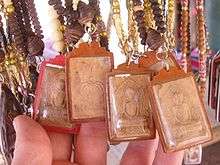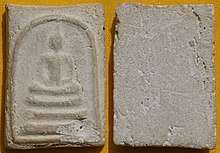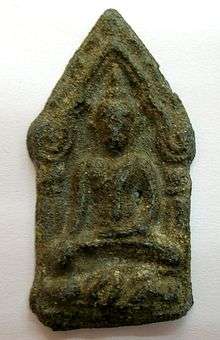Thai Buddha amulet
A Thai Buddha amulet (Thai: พระเครื่อง; RTGS: phrakhrueang), often referred to academically as "votive tablet", is a kind of Thai Buddhist blessed item. It is used to raise funds to help the temple producing the amulets. Worshippers can obtain an amulet or Thai Buddhist monk blessing by simply donating money or offering oil to the temple. After the donation, the monk will give them an amulet as a gift. The amulets no longer simply are considered a "gift", but a tool to help enhance luck in different aspects of life. People use amulets to improve their marriage, wealth, health, love and relationships.

It is a Thai tradition to place amulets under a stupa or other temple structure when it is built. When the structure collapses, many amulets may be found. Some can be over a century old.[1][2]
Almost every Thai Buddhist has at least one Thai amulet. It is common to see young or elderly people wear one or many amulets around the neck in order to get closer to the Buddha.
.jpg)
_29.jpg)
Amulets are made using the Buddha image, an image of a famous monk, or even an image of the monks who made the amulets. Amulets vary in size, shape, and materials such as plaster, bone, wood, or metal. They may include ash from incense or old temple structures, or hair from a famous monk to add protective power to the amulets.[3] After the amulets are made, the maker will then ask the monks who live in the temple or monks from other temples to join together and practice will, chant, pray, and bless the amulets. This process may take from a week to more than three years.
When a new amulet is freshly made, its plaster appearance may not be attractive or gorgeous. By adding a protective casing, the appearance of the amulet is enhanced and at the same time the amulet inside is protected. The price of an amulet not only depends on its appearance, but also on its scarcity, its maker, its age, and its magic classes as well.
Famous markets for amulets include the Tha Phrachan Market next to Thammasat University.[4] However, many amulets at the Tha Prachan market are considered to be fake, meaning replicas that have not been blessed by a monk. Genuine amulets are rare at the Tha Prachan Market. Many collectors and devotees have a trusted dealer of authentic amulets, for the study and authentication of real amulets is as complex a matter as is to be found in the antique trade, or in similar niches such as stamp collecting. Forgeries are rife, and it takes decades of study and experience to develop the skills needed to recognise authentic amulets. There are literally millions of editions from thousands of temples, spanning centuries, and it is not possible for one person to harbor the knowledge to be able to authenticate every single edition. Hence, each expert has his own chosen line of amulets, of a particular type, temple, or artisan, which he chooses as his personal field of expertise.
Famous Thai amulets
Benja Phakhi
The most famous of Thai amulets are the set of five rarest and highly sought after amulets Phra Somdej Wat Rakhang (Thai: พระสมเด็จวัดระฆัง), Phra Rod (Thai: พระรอด), Phra Nang Phaya (Thai: พระนางพญา), Phra Phong Suphan (Thai: พระผงสุพรรณ), and Phra Sum Kor (Thai: พระซุ้มกอ), together called Benja Phakhi (Thai: เบญจภาคี).[5] They are valued at over 10 million baht.[6]
Phra Somdej

Phra Somdej (Thai: พระสมเด็จ) amulets are the "king of amulets", also known as "lucky amulets". Each amulet collector must have one and it is the best and foremost choice to the new believer of Thai amulet. Para Somdej has the noblest status in Buddhism. The most famous of this kind is the Phra Somdej Wat Rakhang produced around 1866 to 1871, by Somdej Toh of Wat Rakhang Khositaram (Thai: วัดระฆังโฆษิตาราม),[7] who is also one of the most respected monks in Thailand.
Phra Somdej Chitralada are the amulets made by King Bhumibol himself and awarded from 1965 to 1970 to selected soldiers, policemen, government officers and citizens.[8] No more than 3,000 of these amulets were made. Each amulet is accompanied with certificate stating the name of recipient, date, and amulet number. As of 2013, a Phra Somdej Chitralada is worth at least two million baht.
In general, most Phra Somdej amulets do not have eyes, nose, and mouth. The Buddha in Phra Somdej is seated on the three-level throne representing the three worlds system of Buddhist cosmology. Although the Phra Somdej have later appeared with five, seven, nine, ten, or thirteen level thrones, the concept of the throne is still the same. Like other Thai amulets, Phra Somdej is usually made of temple dirt, pollen, monk's hair as well as other relics from famous monks or the holy robe "cīvara" worn by the monk.
The functions of Phra Somdej amulets range from protection to enhanced personal relationships, better health, protection from black magic, blocking disasters, and to strengthen careers as well as adjusting the human aura field. Most importantly, it can help bring peace to different walks of life.
Phra Rod
Phra Rod refers to amulets discovered in the early King Chulalongkorn era inside a partially collapsed stupa in Wat Mahawan (Thai: วัดมหาวัน) in Lamphun Province. It was named Phra Rod because the Buddha image in the amulet matched the ancient Buddha image in the temple's ubosot called Phra Rod Luang (Thai: พระรอดหลวง). Legends say that when the temple was part of Hariphunchai Kingdom, the amulets were crafted by Rishi to hand out to citizens during wars and those remaining were placed inside the temple's stupa.[5]
Phra Nang Phaya
Phra Nang Phaya amulets from Wat Nang Phaya in Phitsanulok Province is believed to have been commissioned by Queen Wisutkasat of the Ayutthaya Kingdom. The amulet was discovered when workers dug up an area in the temple to prepare the stage for King Chulalongkorn's visit for the casting of a replica of famous Buddha image Phra Phuttha Chinnarat (Thai: พระพุทธชินราช). This amulet was also discovered in nearby temples such as Wat Ratchaburana (Thai: วัดราชบูรณะ).[5]
Phra Phong Suphan
Phra Phong Suphan is from Wat Phra Si Rattana Mahathat (Thai: วัดพระศรีรัตนมหาธาตุ) of Suphanburi Province. There were thieves who came to dig under the large stupa in the temple and stole amulets and tablets, some made of gold. In 1913 the Suphanburi governor ordered a formal dig to uncover buried amulets. Phra Phong Suphan was among the amulets found.[5]
Phra Sum Kor
Phra Sum Kor is from Kamphaeng Phet Province. When Somdej Toh came to visit relatives in 1849, he found Phra Sum Kor amulets at Wat Phraboromthat Nakhonchum (Thai: วัดพระบรมธาตุนครชุม) together with tablets explaining the amulet making process. He later used the instructions to make his own Phra Somdej Wat Rakhang. This amulet is found throughout Thung Sethi (Thai: ทุ่งเศรษฐี) in Kamphang Phet Province.[5]
Phra Khun Phaen

Phra Khun Phaen (Thai: พระขุนแผน) are amulets which usually feature the Buddha in samadhi or other mudra and should not be confused with the "Khun Phaen" sans "phra", which are amulets made in the likeness of the Phra Khun Phaen, but with a separate deity/historical figure. The original Phra Khun Phaen amulets came before the Khun Phaen but the name is derived from the popularity of the Khun Phaen folklore of the time, and because there was no particular name given to the Phra Khun Phaen, the name was simply borrowed with the attached "phra" (พระ) to denote holiness. Khun Phaen are amulets with the image of Khun Phaen of the classic Khun Chang Khun Phaen folklore. According to the folklore, Khun Phaen was proficient in using magical powers including amulets and other items in battle. Khun Phaen also used a love formula to attract women. Thus, one of the main functions of Khun Phaen is to enhance human relationships: personal relationships, marriage and heterosexual relationships. Also, it helps to enhance career success. The Khun Phaen amulets range from near identical likeness to the Phra Khun Phaen to the more intricate molds containing imagery of the infamous Kumarn Tong (golden child) to Khun Paen and his many consorts.
Jatukham Rammathep
Jatukham Rammathep (Thai: จตุคามรามเทพ) is the name of two princes from Srivijaya Kingdom.[9] Nakhon Si Thammarat Province locals consider Jatukham and Rammthep as the guardian angels of the city. The Jatukham Rammathep amulet was first created by police Khun Phantharak Rajjadej (Thai: ขุนพันธรักษ์ราชเดช) in 1987 as part of Nakhon Si Thammarat's Lak Mueang establishment. The amulet is round, typically with the image of Hindu deities and around 5 cm in diameter. It became popular in the early-2000s, especially during the time of Khun Phantharak Rajjadej's funeral on 5 July 2006 till mid-2007. The amulet was believed to protect its owner from danger and to make its owner rich. As many as 150 series of Jatukham Rammathep amulet production were planned for the year 2007 and the value of market for the amulet reached 20 billion baht that year.[10] In late-2007 it appeared that the Jatukham Rammathep amulet bubble had burst. Its popularity quickly faded with plenty of amulets left that could be obtained at low prices.[11]
Phra Kring
The Phra Kring is a metallic statuette in the image of a meditating Buddha, which is only made in Thailand. The Phra Kring is essentially a Mahayana-style Buddha image, despite the fact that Thailand adheres to Theravada Buddhism. The beliefs about the powers of the Phra Kring, are that the Phra Kring is the image of Pra Pai Sachaya Kuru (พระไภษัชยคุรุ Bhaisajyaguru, 藥師佛 Yàoshīfó, in Chinese, or in Japanese 'Yakushi'), the medicine Buddha. The image is normally in the posture of sitting and holding an alms bowl or a guava, gourd or a vajra. This was a fully enlightened Buddha, who achieved purity of body and mind, and who was a great teacher of human beings, who has the miracle that he who hears his name in passing, or see his image, will be healed, and live a long healthy and prosperous life with wealthy standing. The Pra Kring Buddha, or Bhaisajyaguru is one of seven Bhaisajayagurus and is said to have two Bodhisattvas under him; Pra Suriya Bprapaa Potisat (Suriya Bhrapa Bodhisattva) and Pra Jantra Bprapaa Potisat (Chandra Bhrapa Bodhisattva). Of all the other Buddhist countries who revere it, only Thailand makes its amulet. The Phra Kring in most cases (except in the odd example where Muan Sarn powders prevent the sound), will have a rattling bead inside it. The reason for this rattle sound, made by a sacred bead of Chanuan Muan Sarn or other relic, is that it is the name of the medicine Buddha resounding, as you pass along your way, healing and blessing you with safety, health, prosperity, metta for auspicious friendly loving kindness. Some Phra Kring however do not make a sound that is audible to humans, but still have a piece of Chanuan within, which emits the name of the medicine Buddha silently, only audible on the spiritual plane.
Amulet taboos
- Do not wear Buddhist amulets under the waist. For most amulets, wear it on the neck or above the waist. This tradition is to show respect to the Buddha. Takruts, another type of amulet made in Thailand but without a monk or Buddhist image, can be put inside pants pockets.
- Do not put a Buddhist amulet in a bedroom if you expect to engage in sex there.
- Pray before and after wearing an amulets.
- Remove amulets when bathing.
- It is not necessary to wear an odd number (1,3,5) of amulets around the neck for balance and symmetry.
Prayer
Vandana
Namo tassa bhagavato arahato samma sambuddhassa: This is a prayer to honor to the blessed one, the exalted one, the fully enlightened one. People usually say this prayer three times before and after wearing on the amulet. Saying this prayer means showing absolute respect to the Buddha. This prayer can also be said before and after meditation.
Puttang Ārātanānang Tammang Ārātanānang Sangkang Ārātanānang (make a wish or prayer) Puttang Bprasittimē Tammang Bprasittimē Sangkang Bprasittimē: This is a special mantra or prayer in Pāli for praying to amulets to beseech blessings. It is called Kata Ārātanā Pra Krueang.[12]
References
- "(in Thai) Amulets found under old 200-year-old stupa, people came to dig, and collector paid up to 3 Million for them". 2013-04-21. Retrieved 2015-09-07.
- "(in Thai) Thousand of century-old amulets found, amulet collectors flocked the place". 2013-04-21. Retrieved 2015-09-07.
- "Bangkok Buddhist amulet market". CNN Travel. 2009-10-21. Retrieved 2015-09-05.
- Pergament, Danielle (2005-12-18). "Amulets in Bangkok". New York Times. Retrieved 7 August 2018.
- "(in Thai) Follow the Trail of Benja Phakhi, The Origins of Most Sought After by Amulet Collectors". 2014-07-13. Retrieved 2015-09-05.
- "(in Thai) Phra Benja Phakhi". 2014-08-05. Retrieved 2015-09-05.
- "(in Thai) Phra Somdej Wat Rakhang, large die variant with names given for all 5 individual dies". 2015-02-07. Retrieved 2015-10-04.
- "(in Thai) Highly Desirable Phra Somdej Chitralada". 2013-05-04. Retrieved 2015-09-09.
- "Who is Jatukham Rammathep?". 2007-04-17. Retrieved 2015-09-08.
- "Thai amulet craze "unacceptable face of Buddhism"". Reuters. 2007-07-11. Retrieved 2015-09-05.
- "Losing its charm The bottom seems at last to have fallen out of the Jatukam market". The Nation. 2007-08-26. Retrieved 2015-09-08.
- (Special kata for Thai Amulets Ajarn Spencer Littlewood)
External links
- What do Pra Khun Phaen and the Chinarat Buddha have in Common?
- Pra Kru Tap Khaw Ancient Amulet Hiding Place Find
- Pra Somdej Wat Rakang Kositaram Buddha Amulets
- Buddhas-Magic.com
| Wikimedia Commons has media related to Amulets of Thailand. |